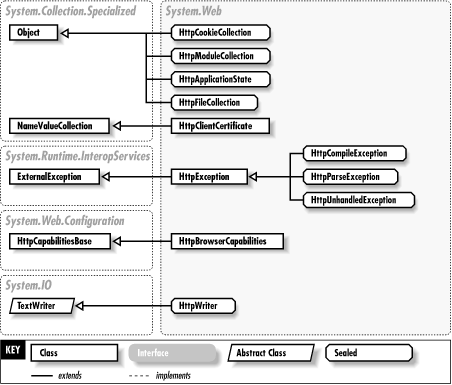Chapter 21. Namespace Reference
The quick reference is organized into chapters-one per namespace. Each chapter begins with an overview of the namespace and includes a hierarchy diagram for the types (classes, interfaces, enumerations, delegates, and structs) in the namespace. Quick-reference entries for all the types in the namespace follow the overview.
Figure 21-1 is a sample diagram showing the notation used in this book. This notation is similar to that used in O’Reilly’s Java in a Nutshell, but it borrows some features from UML.

Figure 21-1. Class hierarchy notation
Classes marked as MustInherit are shown as a
slanted rectangle; classes marked as NonInheritable are
shown as an octagonal rectangle. Inheritance is shown as a solid line
from the subtype, ending with a hollow triangle that points to the base
class. Two notations indicate interface implementation. The lollipop
notation is used most of the time, since it is easier to read. In some
cases, especially when many types implement a given interface, the
shaded box notation with the dashed line is used.
Important relationships between types (associations) are shown with a dashed line ending with an arrow. The figures don’t show every possible association. Some types have strong containing relationships with one another. For example, a System.Net.WebException object instance includes a System.Net.WebResponse object instance that ...
Get ASP.NET in a Nutshell now with the O’Reilly learning platform.
O’Reilly members experience books, live events, courses curated by job role, and more from O’Reilly and nearly 200 top publishers.

